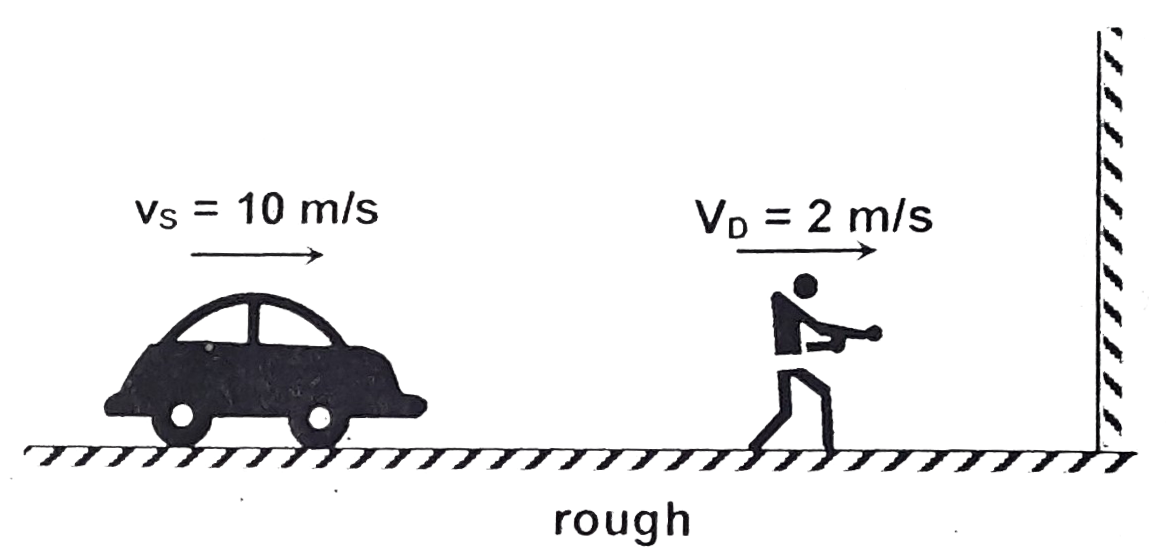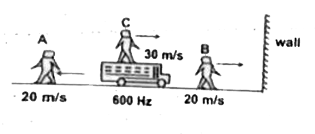A car travels at a speed of 'a' towards a high wall. The driver sounds a horn of frequency 'n'. If V is the velocity of sound in air, frequency of reflected sound heard by the driver is
nV+aV−a
nV−aV+a
nV+aV
nV−aV
The correct Answer is:A
To solve the problem of finding the frequency of the reflected sound heard by the driver in the car, we can break down the solution into clear steps.
1. Identify the Given Variables:
- Speed of the car (source) = a
- Frequency of the horn (source frequency) = n
- Velocity of sound in air = V
2. Determine the Frequency Heard by the Wall (Observer):
- The car is moving towards a stationary wall.
- The formula for the frequency heard by a stationary observer when the source is moving towards it is given by:
F1=F0VV−Vs
- Here, F0=n (the frequency of the horn), and Vs=a (the speed of the car).
- Substituting these values into the formula:
F1=nVV−a
3. Determine the Frequency of the Reflected Sound Heard by the Driver:
- Now, the wall acts as a source of sound emitting frequency F1, and the driver in the car is the observer moving towards this source.
- The formula for the frequency heard by a moving observer when the source is stationary is:
F2=F1V+VoV
- Here, Vo=a (the speed of the driver towards the wall).
- Substituting for F1:
F2=(nVV−a)V+aV
4. Simplify the Expression:
- Simplifying F2:
F2=nV(V+a)V(V−a)=nV+aV−a
5. Final Result:
- The frequency of the reflected sound heard by the driver is:
F2=nV+aV−a
- Speed of the car (source) = a
- Frequency of the horn (source frequency) = n
- Velocity of sound in air = V
- The car is moving towards a stationary wall.
- The formula for the frequency heard by a stationary observer when the source is moving towards it is given by:
F1=F0VV−Vs
- Here, F0=n (the frequency of the horn), and Vs=a (the speed of the car).
- Substituting these values into the formula:
F1=nVV−a
- Now, the wall acts as a source of sound emitting frequency F1, and the driver in the car is the observer moving towards this source.
- The formula for the frequency heard by a moving observer when the source is stationary is:
F2=F1V+VoV
- Here, Vo=a (the speed of the driver towards the wall).
- Substituting for F1:
F2=(nVV−a)V+aV
- Simplifying F2:
F2=nV(V+a)V(V−a)=nV+aV−a
- The frequency of the reflected sound heard by the driver is:
F2=nV+aV−a
Topper's Solved these Questions
- BOOK - AAKASH SERIESCHAPTER - WAVESEXERCISE - EXERCISE-III (Wave Equations & Basics)7videos
WAVES
- BOOK - AAKASH SERIESCHAPTER - WAVESEXERCISE - EXERCISE-III (Strings (Speed of travelling wave))15videos
WAVES
- BOOK - AAKASH SERIESCHAPTER - WAVESEXERCISE - EXERCISE-II (Beats : )20videos
WAVES
- BOOK - AAKASH SERIESCHAPTER - WAVE OPTICSEXERCISE - PROBLEMS (LEVEL - II)33videos
WAVE OPTICS
- BOOK - AAKASH SERIESCHAPTER - WAVES OPTICSEXERCISE - EXERCISE -III (POLARISITION)10videos
WAVES OPTICS
Similar Questions
The driver of a car travelling with speed 30ms−1 towards a hill sounds a horn of frequency 600 Hz. If the velocity of sound in air is 330ms−1, the frequency of reflected sound as heard by driver is
View SolutionA bus is moving with a velocity of 5ms−1 towards a huge wall. The driver sound a horn of frequency 165 Hz. If the speed of sound in air is 335ms−1, the number of beats heard per second by a passenger inside the bus will be
View SolutionA car is moving towards a high cliff. The car driver sounds a horn of frequency f. The reflected sound heard by the driver has a frequency 2f. if v be the velocity of sound, then the velocity of the car, in the same velocity units, will be
View SolutionA car is moving towards a high cliff. The car driver sounds a horn of frequency f. The reflected sound heard by the driver has a frequency 2f. if v be the velocity of sound, then the velocity of the car, in the same velocity units, will be
View SolutionA car is moving with a constant velocity 10m/s towards the stationary wall. The car blows a horn of frequency 320Hz. The velocity of sound in air is 330m/s. The beats frequency received by the observer is
 View Solution
View Solutiona bus is moving with a velocity 4 m/s towards a wall, the driver sounds a horn of frequency 173 Hz . if the speed of sound in air is 350 m/s. the number of beat heard per second by a passanger on the bus will be
View SolutionA car travelling with speed V50 towards a hill, (where v is speed of sound in air), sounds a horn of frequency 196 Hz. The number of beats heard per second by the driver when reflected sound reaches the driver is
View SolutionA source of sound which emitting a sound of frequency 600 Hz is moving towards a wall with a velocity 30 m/s. Three observes A, B, C moving with velocity 20 m/s, A away from the wall and B towards the wall and Inside the source, Velocity of sound in air is 330 m/s.

Find the frequency of reflected sound observed by observer BView SolutionA person P is standing at perpendicular distance of 100 m from point Q on a highway.A bus B is moving with a speed of 30√2 m/s toward point Q on the highway.The driver of the bus blows a horn of frequency 1200 Hz . The frequency of the sound received by the person P, when the bus emits sound when it is at distant 100 m from Q is [ speed of sound in air is 330 m/s]
View SolutionAssertion : A train is approachinng towards a hill . The driver of the train will hear beats.
Reason : Apparent frequency of reflected sound observerd by driver will be more than the frequency of direct sound observered by him.View Solution

